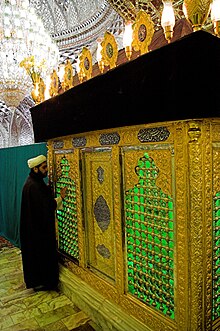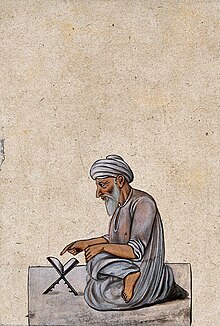Mullah

| Part of a series on Islam |
| Usul al-Fiqh |
|---|
| Fiqh |
| Ahkam |
| Legal vocations and titles |
|
Mullah (
The title has also been used in some Mizrahi and Sephardic Jewish communities in reference to the community's leadership, especially its religious leadership.[2]
Etymology
The word mullah is derived from the
Usage
Historical usage

The term has also been used among
Modern usage
It is the term commonly used for village or neighborhood mosque leaders, who may not have high levels of religious education, in large parts of the
In Afghanistan and Pakistan the title is given to graduates of a madrasa or Islamic school, who are then able to become a mosque leader, a teacher at a religious school, a local judge in a village or town, or to perform religious rituals. A person who is still a student at a madrasa and yet to graduate is a talib. The Afghan Taliban was formed in 1994 by men who had graduated from, or at least attended, madrasas. They called themselves taliban, the plural of talib, or "students". Many of the leaders of the Taliban were titled Mullah, although not all had completed their madrasa education.[5] Someone who goes on to complete postgraduate religious education receives the higher title of Mawlawi.[6]
Mullah and its variation mulla have also degenerated into a derogatory term by Islamophobes, for a Muslim priest that connotes a semiliterate, backward, often bigoted village imam.[7][8][9][10][11][12]
In
Training and duties
Ideally, a trained mullah will have studied the traditional Islamic sciences not limited to:
- Classical Arabic
- Nahw (syntax)
- Sarf (word morphology)
- Balaaghah (rhetoric)
- Shi'r (poetry)
- Adab (literature)
- Tarikh (history)
- Islamic law (fiqh)
- Rulings pertaining to their school of jurisprudence and the rulings of other schools of jurisprudence
- The principles of jurisprudence pertaining to their school of jurisprudence and the principles of other schools of jurisprudence
- The evidences of their school of thought for principles and rulings, the evidences of others, how they differ and why
- Islamic traditions (hadith)
- Exegesis
- The principles of exegesis
- Aqidah (Islamic creed)
- Mantiq (logic)
- Ilm-ul-Kalaam (philosophy)
- (Quran)
- The meanings of the Quran
- Exegesis
- the principles and rules of Quranic exegesis
- Tasawwuf(Sufism)
Some mullahs will specialise in certain fields after completing the above foundational studies. Common specialties are:
- Iftah – after which they qualify as a mufti and can issue a fatwa (legal ruling)
- Takhasus fil Hadith – specialisation in hadith studies
- Takhasus fil Aqidah – specialisation in aqidah studies
Such figures often have memorized the Quran and historically would memorise all the books they studied. However in the modern era they instead memorise the founding books of each field (sometimes in the form of poetry to aid memorisation).
Uneducated villagers may frequently classify a literate Muslim with a less than complete Islamic training as their "mullah" or religious cleric. Mullahs with varying levels of training lead prayers in mosques, deliver religious sermons, and perform religious ceremonies such as birth rites and funeral services. They also often teach in a type of Islamic school known as a
Mullahs have frequently been involved in politics, but only recently have they served in positions of power, since Shia Islamists seized power in Iran in 1979.
Dress

The dress of a Mullah usually consists of a turban (Persian: عمامه ammāme), a long coat with sleeves and buttons, similar to a cassock (قبا qabā), and a long gown or cloak, open at the front (عبا abā). The aba is usually made either of brown wool or of black muslin. It is sleeveless but has holes through which the arms may be inserted. The turban is usually white, but those who claim descent from Muhammad traditionally wear a black turban.[15]
See also
- Allamah
- Marja'
- Maulana
- Maulvi
- Ulema
- Seghatoleslam
References
- ^ a b Szczepanski, Kallie (16 October 2019). "Islamic Mullah". ThoughtCo. Retrieved 10 September 2021.
- ^ See for example: "Rabbinic Succession in Bukhara 1790–1930" Archived 7 May 2017 at the Wayback Machine
- ^ Chinese and Japanese repository of facts and events in science, history and art, relating to Eastern Asia, Volume 1. Oxford: s.n. 1863. p. 48. Retrieved 6 July 2011. (Original from the University of Michigan)
- ^ ISBN 0-674-29140-9.
- ISBN 0195792742. Retrieved 18 September 2021.
- ISBN 9781849040266. Retrieved 18 September 2021.
- ^ Aziz, Abdul. "Words like Katuwa, Mullah, Atankwadi by BJP MP were also for global Muslim leaders too whom Modi hugs". eNewsroom India. Retrieved 29 May 2024.
- ^ 1975, Area Handbook for Bangladesh, Page 117.
- ^ 1975, Area Handbook for Bangladesh, Page 117.
- ^ Sai Felicia Krishna-Hensel, Authoritarian and Populist Influences in the New Media Archived 2 November 2022 at the Wayback Machine
- ^ 1995, Religion and Society Archived 2 November 2022 at the Wayback Machine, Volume 42, Page 23.
- ^ Salman Shami, 2017, The Blasphemy Law Archived 2 November 2022 at the Wayback Machine.
- ^ Algar 1987
- ^ Momen, Moojan, An Introduction to Shi'i Islam, Yale University Press, 1985, p. 203
- ^ Seyyed Behzad Sa'adati-Nik Tarīkhche-ye Lebās-e Rūhānīat (The History of Clerical Dress) Archived 2 November 2022 at the Wayback Machine. Mehr News, 29 Tir 1394.
 This article incorporates text from Chinese and Japanese repository of facts and events in science, history and art, relating to Eastern Asia, Volume 1, a publication from 1863, now in the public domain in the United States.
This article incorporates text from Chinese and Japanese repository of facts and events in science, history and art, relating to Eastern Asia, Volume 1, a publication from 1863, now in the public domain in the United States.
External links
- . New International Encyclopedia. 1905.
- International Imam Organization
